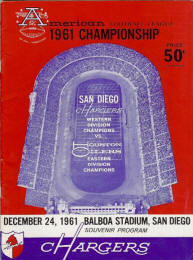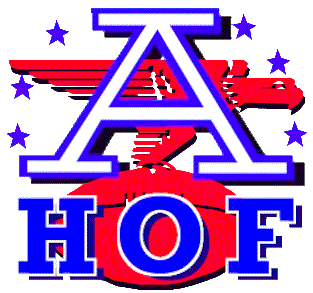|
Again
the AFL had played a fifteen-week season, with each team drawing a bye
at some point during the season, and playing every other team twice.
And again the combatants in the ultimate game
were the Eastern Division Champion Oilers and the Western Division
Champion Chargers. However, although the Oilers still represented
Houston (with ten wins, three losses and a tie), the Chargers were now
the San Diego Chargers, with the league's best record at 12-2.
Sid Gillman's Chargers still had qb
Jack Kemp, rb
Paul
Lowe, te
Dave Kocourek, ot
Ernie Wright, ot
Ron Mix, de
Ron Nery and lb-p
Paul
Maguire, and had added defensive muscle like massive
Ernie Ladd and Rookie of the Year
Earl Faison. Oiler coach
Wally Lemm, who compiled a 9-0 record after replacing
Lou Rymkus, also had returning players qb
George
Blanda, rb
Billy Cannon, fb
Charlie
Tolar, wr
Charlie
Hennigan, og
Bob Talamini, de
Don Floyd, and
db Jim
Norton. As in 1960, the
teams had once again split their two regular season encounters:
the Oilers won at home, 34-24,
in week three, and the Chargers took their home game
38-13, on
December 3.
The
AFL Championship
of the 1961 season was
played on Christmas Eve, 1961, at
Balboa Stadium in San
Diego before a
crowd of 29,556. Pre-game
expectations were for a display of offensive fireworks from the
highest-scoring teams in their respective divisions.
But in a league known (and often demeaned) for its
potent offenses, the expected shootout failed to materialize.
Instead, the 1961 American Football League championship game turned out
to be what coaches and players on both sides later characterized as the
toughest defensive battle they had ever been involved with. No
less than thirteen players suffered injuries and had to be helped off
the field. |
|
The Oilers' relentless blitzes pressured Kemp, recording six
sacks. The Oilers' offense, also strongly pressured by the
Chargers, eked out a 10-0 lead on a 46-yard field goal by Blanda
in the second quarter and a 35-yard Blanda-to-Cannon scoring
pass late in the third. Early in the fourth a 12-yard field goal
by George Blair brought San Diego within reach of the Oilers,
but as the Chargers were driving for the tying score late in the
game, Chargers' safety
Julian Spence, at 153 pounds one of the AFL's smallest men,
stepped in front of tight end
Dave Kocourek and picked off Kemp's pass,
sealing the victory for the Houston club. Press reports after
the game cited Oiler coach Wally Lemm as saying he rated the
game as "the most vicious, hard-hitting football game I have
ever seen", and AFL author
Ed Gruver attributes the following quote to long-time San
Diego Tribune AFL columnist
Jerry Magee: "Offense was the thrust of the old AFL. The
league relied on a lot of big plays. But the 1961 championship
was a real hard-hitting game." |
|
 |
|
|
The American
Football League Champions for 1961 were once more the
Houston Oilers,
Just as the Oilers' coach Lou Rymkus in the previous year, Wally Lemm
was named the AFL's Coach of the Year for 1961, the first and only time
that a team won a championship in two consecutive years, headed by
different coaches who received coach of the year honors. This
time, enigmatic owner
Bud Adams shelled out for championship rings. But it still
sticks in my craw that the team that won the first two American Football
League Championships (and introduced the fans of Houston to major league
sports) no longer exists, and that the name
Oilers can never be used for
any franchise, including Houston's. |
|
Standing: |
John Breen (Director of Player Personnel),
Bud Adams (Owner), Don Suman
(General Manager), Dave Smith,
Tony Banfield, Orville Trask,
Ed Husmann, Al Jamison,
Billy Cannon,
Dalva Allen, George Shirkey,
Jack Laraway,
Don Floyd,
George Blanda, Joe Spencer (Assistant Coach), Walt Schlinkman (Assistant Coach), and Wally
Lemm (Head Coach). |
|
Middle Row: |
Mark Johnson (#41), Mike Dukes, Julian
Spence, Dennit Morris,
Bob Talamini, Ron Botchan,
Jacky Lee, Dick Frey, Claude King,
Freddie Glick,
Doug Cline,
Jim Norton, and Bobby Brown (Trainer). |
|
Bottom Row: |
George Greene (Equipment Manager), Bob
Kelly, Bob Schmidt, Hogan Wharton,
Bob McLeod, Bill Groman,
Charlie Hennigan, Rich Michael,
Charley Tolar, Willard Dewveall, John White. |
|
Team photo courtesy of Jack Laraway |
|






